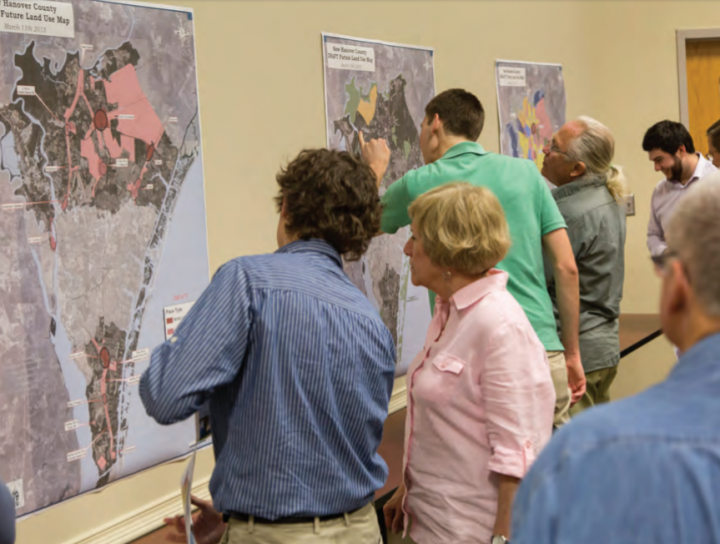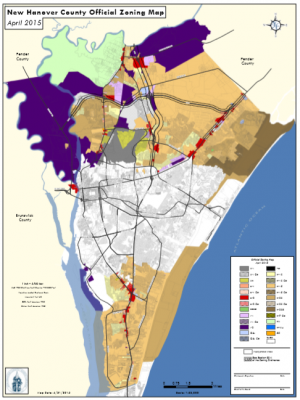
This story was updated April 5 to more precisely describe the timeline of the UDO/special use permit update process.
WILMINGTON – A draft of New Hanover County’s updated rules and guidelines for property development will soon be available for public review.
Supporter Spotlight
The first of a three-phase project modernizing the county’s unified development ordinance, or UDO, is set to be made public at the end of the New Hanover County Planning Board’s meeting set for 6 p.m. Thursday in Room 301 of the courthouse at 24 N. Third St. That meeting will be followed by a workshop May 1 for the public to make comments about the roughly 200-page draft.
Over the course of about five months, county planners have been updating and fine-tuning the first phase draft, which includes zoning districts, use standards, table of permitted uses and definitions.
County planners decided to break the UDO update process into three phases to give the public an opportunity to review and digest the proposed rules and definitions over time rather than hand them a 300-plus page book, New Hanover County Planning Director Wayne Clark said.

“The thought process is that if you try to bring that out for people to absorb and elected officials to adopt as a whole, that’s a lot,” he said. “We did understand that there was some community interest in what’s going on. Probably from the outside, even with our website, people weren’t sure what was happening. I thought it was better to put something out there for people to see and touch than to continue to wait as long as they’re aware that this is not the code we’re ready to adopt.”
Special-use permits are a way to making zoning rules more flexible by permitting, under certain conditions, property uses not allowed by right, such as operations that could affect surrounding areas.
Supporter Spotlight
This includes animal slaughtering and processing; paper and paperboard mills; petroleum and coal products manufacturing; pesticide, fertilizer and other agriculture chemical manufacturing; explosives manufacturing; and alumina refining, secondary smelting and alloying of aluminum production.
Under the updated rules, these industries will be permitted as a special use only in the county’s heavy industrial district.
The amendments are part of the county’s first-ever comprehensive approach to update the decades-old UDO.
Since the county’s zoning code was first adopted in 1969, piecemeal amendments have been made, new chapters added and new zoning tools, such as conditional zoning rules, have been added throughout the years.
When the UDO was adopted, its rules were centered around post-World War II development, one that promoted segregation of different land uses rather than mixed-use development, explained New Hanover County Planning Manager Ken Vafier.
Throughout what Vafier said has been a “very, very detailed process,” county planning staff has sifted through the code line-by-line, simplifying and re-categorizing the table of permitted uses and updating definitions, removing words like “cabaret” and “disco.”

Clark said that small details, like regulations on what are typically temporary uses, such as Christmas tree sales and pumpkin sales, have been examined and, in some cases, revamped.
“It’s easier to find what you’re looking for, but it didn’t change the existing zoning district structure where these things can be done,” Clark said.
Overall, New Hanover County has 16 zoning districts and 250 permitted uses.
A large majority of the county is zoned residential.
“Probably one of the most interesting things with phase one is that we’re kind of a limited number of districts,” Clark said. “There’s not a multi-family district. There’s only a couple commercial districts and there’s not very much zoned in our traditional commercial districts and so the comprehensive plan calls for mixes of uses and a little bit more density.”
The second phase will include development standards, such as parking, landscaping, buffering and signage rules. County planners anticipate a summer release of that phase.
The third phase will include administrative procedures and processes. This last phase is projected to be released in the fall.
Throughout this process, county planners will continue discussions with city of Wilmington planners in an effort to ensure some of the technical terms in the draft UDO overlap with the city’s existing zoning terms.
“The areas that are College Road and Market Street, to the people who live here, those are invisible government lines, so the development we’re at least trying to make sure there are some similarities,” Clark said.
At least one public workshop will be held following the release of each phase giving residents, business owners and various stakeholders the opportunity to be part of the process along the way, Vafier said.
“This gives us the ability to work through the document incrementally and gain consensus on certain things as we’re moving through the process,” he said. “We need an efficient process and consensus along the way. We’re not limited to a certain number of those workshops. It will be as many as we need to get through that section of the draft.”
If there’s a specific topic that receives a lot of attention, county officials can host a workshop specific to that topic, he said.
The county will also accept written comments throughout the UDO updating process on the county planning website.
“We won’t stop people from providing input any way they want to,” Clark said.
A final draft of the revised UDO could be put to a vote of the county planning board, then commissioners, by next spring.
“We do expect there’s going to be some back and forth to make sure that it gets done right,” Clark said. “There’s a skeleton in there for these zoning districts but they’re not fleshed out completely. We’ll talk to people until we’ve got enough to make a recommendation.”







